Fruit Genetics Friday #1b: Polyploidy
(And yeah, I know it's Saturday...)
Well, here I am at 1:34am in the lab, waiting an hour so I can dump a little media onto a couple of plates and go home, so I thought maybe to pass the time I'd give you folks a real post for a change.
This is Fruit Genetics Friday #1b, because there's another #1 that covers the real basic stuff that isn't finished, and might never be. Frankly, basic genetics, while certainly cool, gets a little old to write a ton about, and I'm guessing my average reader remembers the really basic stuff. If you don't, feel free to ask questions. I won't think any less of you for it.
So on to the fruit genetics and one of my favorite topics, polyploidy:
One of the first major wrinkles one runs into when trying to understand the genetics of many fruit crops is polyploidy. Remember how people (and most animals and many plants) have two of each gene, one copy from each parent? That makes them diploid. That's sort of the basic model, and in the animal world it's the most common one. But in plants (and a few insects, reptiles, and amphibians), it's not uncommon to have more than the basic two sets of chromosomes, a condition called polyploidy ("di" meaning two, vs. "poly" meaning many, see?). Estimates are all over the place, but somewhere in the vicinity of 70% of plant species (angiosperms, anyway) are or have been polyploid at some point in their evolutionary past. An awful lot of crop species are polyploid, partly because one of the traits of polyploids is that they tend to be bigger than the their diploid counterparts, and in general bigger has been considered better when it comes to crop development.
For example, I started my career working with a diploid species, grapes, did my M.S. working with tetraploid blackberries (four sets of chromosomes), and now work with strawberries, which are octoploid (eight sets of chromosomes.) The cultivated strawberry is among the crops with the highest ploidy level, although there are blackberry species with as high as twelve sets of chromosomes (dodecaploid maybe? I get mixed up past ten. By the way, standard shorthand for these things is to use "x" to represent the basic chromosome set for a species, so a diploid is denoted as 2x, and tetraploid, 4x, etc.)
Just like diploids, when polyploids reproduce, they form eggs and pollen cells containing half the normal complement of chromosomes. This generally works pretty well if you've got an even number of sets of chromosomes, but it becomes a problem in odd-ploid plants. If you've got three copies of a particular chromosome, and the cells splits to form two pollen grain, what happens to the extra? The answer varies...sometimes one cell gets it and the other doesn't, sometimes it's just lost. The result, anyway, is reproductive cells that are complete mess a lot of the time. This results in sterile plants. A good example of this is the cultivated banana, which is triploid. Wild, diploid bananas are full of seeds, but because cultivated types can't produce viable sex cells, no fertilization takes place, and we get our nice soft, seedless bananas (although some one once told me that about one in every five or ten thousand bananas will contain a viable seed, the result of the off chance that a particular combination of chromosomes works out).
There are two types of polyploids, which are formed in two different ways. The simplest kind of polyploid is called an autoploid. In an autoploid, all the chromosome sets come from the same species. This can come from a spontaneous doubling in a vegetatively propagated plant (this happens when a cell basically makes a mistake mid-division and fails to divide after duplicating it's chromosomes). This has, for example, resulted in a handful of grape cultivars, such as 'Pierce', which was identified as a large-fruited shoot on an 'Isabella' vine. The other possible cause is the tendency of plants to occasionally produce sex cells with double the normal genetic complement, which are called "unreduced gametes". These unreduced gametes can also join to produce autoploids.
The other kind is called an alloploid. Alloploids have two or more different types of chromosomes, generally from ancestors of two or more different species. In octoploid strawberry we use the notation AAA'A'BBB'B' to indicate that the eight sets of chromosomes come in four different types, from four different ancestral species. Most crosses between species fail, resulting in sterile progeny (because unlike sets of chromosomes will not pair, it is next to impossible to form viable gametes, just like in an odd-ploid plant). However, if at some point the resulting plant doubles its genetic contents, the problem is solved. A new hybrid with genomes AB can't reproduce, because A chromosomes won't pair with B chromosomes. However, if AB becomes AABB, then the A chromosomes will pair with the other A chromosomes, and the B with the B, and fertility is restored, though frequently at less than perfect levels.
These potential problems with fertility are part of why artificial polyploids have been successful in only a relatively few cases. Even if a plant has big fruit, if it has sterility problems and has trouble actually producing that fruit, it's not going to be a hit. There are other problems, too, though they vary somewhat from species to species. In addition to fertility issues, polyploids tend to be less tolerant of cold, have less rugged shoots, and sometimes have disease issues as well.
Well, my labwork is calling. Next installment I'll look at inheritance in polyploids, and why it's so darn kooky. (I'm hoping to post a list of polyploid fruits here for you, but it's 2:30am, I've got lab work to do and a baby squawking, and I can't get the table HTML right, so it's got to wait.) I realize this may be a tad technical for some folks...like I said, let me know if there's something you're curious about and I didn't do a good job explaining it.
Anyway, good night, folks.
Update: Here's the little table I promised you folks. I really need to get me some fancy program to do my HTML...it's too tiring to do a big table, so this is hardly an exhaustive list, just some examples
Update 2: The table is screwing things up, and my imperfect knowledge of HTML leaves me helpless when it comes to fixing it. So no more table. Sorry. I'd try to sort it out, but I'm way, way, too tired. So anyway, polyploids include blackberries, strawberries, sour cherries, European plums, bananas, blueberries, persimmons, some apples and mandarins, etc.
Labels: Fruit Genetics Friday, genetics


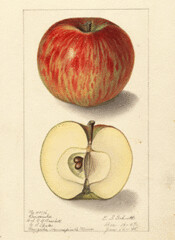
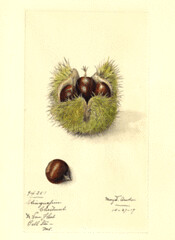
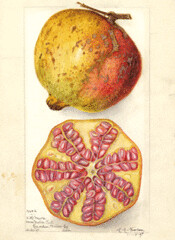
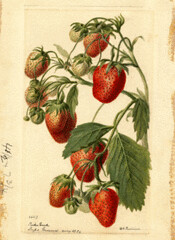
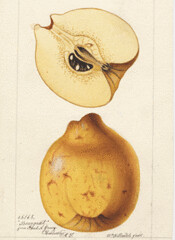



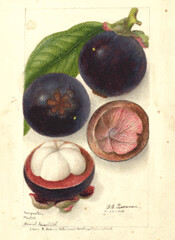
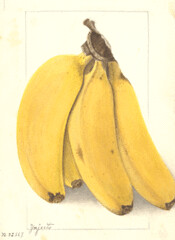

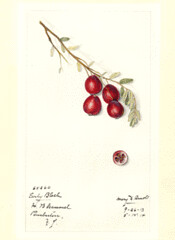
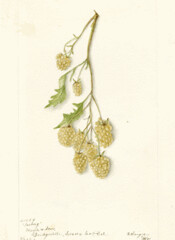
11 Comments:
The number of triploid bananas that have seeds is one in 4194304.
This is because when the seeds are produced, the diploid should split in to two haploids. But the triploid splits into a haploid and a diploid. If all 22 chromsones are haploid, the banana seed will be good, but the chances of getting a haploid is 1/2, the chance of getting 22 haploids is 1/2 to the power 22, which is 1/4194304.
I don't think it quite works that way (although my experience is not with bananas, and it may work differently there). It's cool you did out the math, but there are a couple of complications.
One problem is that for a number of reasons, all permutations of haploid v. diploid for each chromosome are not equally probable. In some triploids, true 2n pollen comprises as much as 12% or more of the pollen generated, and 2n-1 and 2n+1 are disproportionately common, and these could still be functional enough to form. I'm guessing this is also more or less true for female gametes. Also, unreduced gametes will have a full 3n complement.
Secondly, cells abhor unpaired chromosomes. If, for example, a 2n+1 and a 2n gamete fuse, many, many times the extra chromosome gets lost, and you wind up with 4n. Theoretically, the transmission rate of an extra chromosome would be 50%...practically it is NEVER that high, and often as low as 25%.
Thirdly, aneuploid embryos are not necessarily abnormal enough to abort (we're talking seed formation, not yielding a mature plant.) Most 2n+1 embryos and many 2n-1 would yield at least a seed...and maybe 2n+2, and 3n-1. Even if we go with euploid gametes, you'd at least need to double your number, because any combination of n and 2n gametes would certainly yield viable seed.
And, finally, one basic error in your assumptions...there are many ovules in a banana fruit. So if there are 100 ovules in the fruit, and we accept the rest of your calculations, then the number would still be 1/41943 (100/4194304) for the number of bananas that have seeds.
Polyploidy, and aneuploidy especially, is, as you can see, a giant mess. But it's still pretty cool.
And thanks for working out the math...I always think that's fun.
So excited I stumbled upon your blog! Is there a fruit in particular that might make for a good elementary level lab? Everyone always uses vegetables...corn and pea plants. I thought using fruit might make for a fun experience for kids.
Hardwick Hall, Derbyshire
Find out how families pulled together during the war years to celebrate the festive season with this 1940s thrifty Christmas. The dining room, drawing room and bedrooms will be dressed as they would have been on a 1940s Christmas morning, with relevant music. Activities include make do and mend workshops. Christmas at Hardwick, 3 to 4 December, 11 to 3 pm.
computer problems fixedLatest Movies Download
Global stock markets have risen as Europe's leaders called for closer economic integration as the way to ultimately resolve the debt crisis.
US stocks had their best week in more than two years, up 7%. Leading indexes in France, Germany and the UK were all up about 1%.
In a speech to the Bundestag, German Chancellor Angela Merkel said Europe was working towards "fiscal union".
pc laptoptop men hair
Hi! Great post. The only correction was made indirectly by Evil Fruit Lord above. That is, ploidy is designated by "n"...DNA content is designated by "x". For example, x varies with the cell cycle (relative to mitosis) but n does not. In cell cycle relative to meiosis, ploidy (n) changes following meiosis I.
This was such a great explanation of diploid and polyploid. thanks for laying it out there in a really simple, easy to understand way. I'm looking into interspecies hybrids of durians - you don't happen to know much about durian chromosomal make-up or its genetic ancestry, do you?
true religion jeans
nike polo
under armour curry 3
michael kors handbags
longchamp le pliage
off-white clothing
michael kors handbags
yeezy boost 350
hugo boss outlet
coach factory outlet
ralph lauren uk
ray ban eyeglasses
ray ban sunglasses
red bottoms
pandora charms outlet
michael kors outlet
moncler jackets
yeezy
balenciaga
fitflop
red bottom shoes
vans outlet
off white x jordan 1
balenciaga sneakers
yeezy boost 700
hermes
air jordan
yeezy supply
kyrie 6 shoes
longchamp outlet
bape clothing
adidsas yeezy
golden goose sneakers
supreme
golden goose shoes
Post a Comment
<< Home